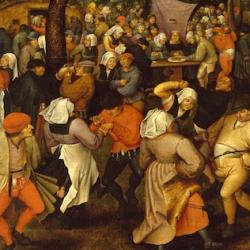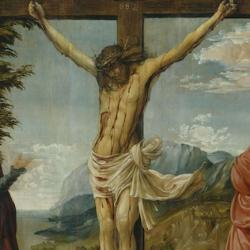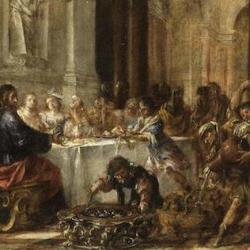A couple more passages from Coloe’s very rich article. She notes that Pilate’s inscription on the cross identifies Jesus not as “a” but as “the” Nazarene. In John, Nazareth is barely mentioned (cf. 1:45-46), and suggests that Pilate’s titlon alludes to Isaiah 11’s prediction of a Messianic Branch ( netser ) from the stump of Jesse. Thus: “Jesus the Branch, King of the Jews.”
Qumran texts link the Branch to the temple-building Branch ( semlah ) of Zechariah 6:12: “Behold the man whose name is the Branch.” Netser and semlah were synonymous titles for the Messianic king who would build the eschatological temple. Pilate, Coloe suggests, quotes the first half of Zechariah 6:12 in presenting Jesus to the Jews: “Behold the man.” By putting “Nazarene” in the titlon , though, he finishes the sentence and names Jesus as the Messiah.
(Does Pilate know what he’s doing? Maybe not; it’s all providential irony. But maybe so; in which case, Pilate certainly intends it as cruel mockery of Jewish hope: “Behold your branch; behold what Rome does to your Messiahs.” In which case the providential irony is perhaps intensified.)
On the cross, Jesus declares that the Beloved disciple is the son of Mary and Mary his mother.
Coloe points out that John does not name Mary but calls her either “his mother” or “the mother” (19:25-26). Jesus’ double “behold” indicates that Jesus pronounces a “prophetic revelation,” and the wording suggests an adoption. But this is not Jesus being a good Jewish boy. It’s establishing a new relationship between the disciple and Mary, and thus between the disciple and Jesus: “If the woman always called “the mother of Jesus” is presented also as the mother of the Beloved Disciple, then Jesus’ sonship is extended to embrace others; the disciple is adopted as Jesus brother/sister and therefore becomes a child of God,” which fulfills the promise of John 1:12: “To those who believe on Him, He gives power to become sons of God.”
The links to the prologue go deeper: “The scene concludes with the disciple taking her ‘to his own’ ( eis ta idia , 19:27), which forms an inclusio with the same expression used of Jesus in the prologue, ‘he came to his own’ ( eis ta idia , 1:11). The inclusio indicates that the action of Jesus coming to his own, is now brought to completion. This scene is the climax of the narrative, bringing the plot announced in the prologue to its conclusion, and the narrator confirms this in v. 28, ‘After this, Jesus knew that all was now finished.’ The personalizing of the temple, begun in the transfer of temple imagery to Jesus (2:21), then continued with the promise of the divine indwellings in the community of believers constituting them as ‘my Father’s Household’ (14:2), is accomplished. This divine filiation is the ultimate revelation of the ‘hour’and brings Jesus’ mission to its completion.”
As He dies, He hands on the Spirit to the new family. Even at the moment of His death, “the Nazarene temple-builder is in the process of raising up a new temple/Household of God.”











